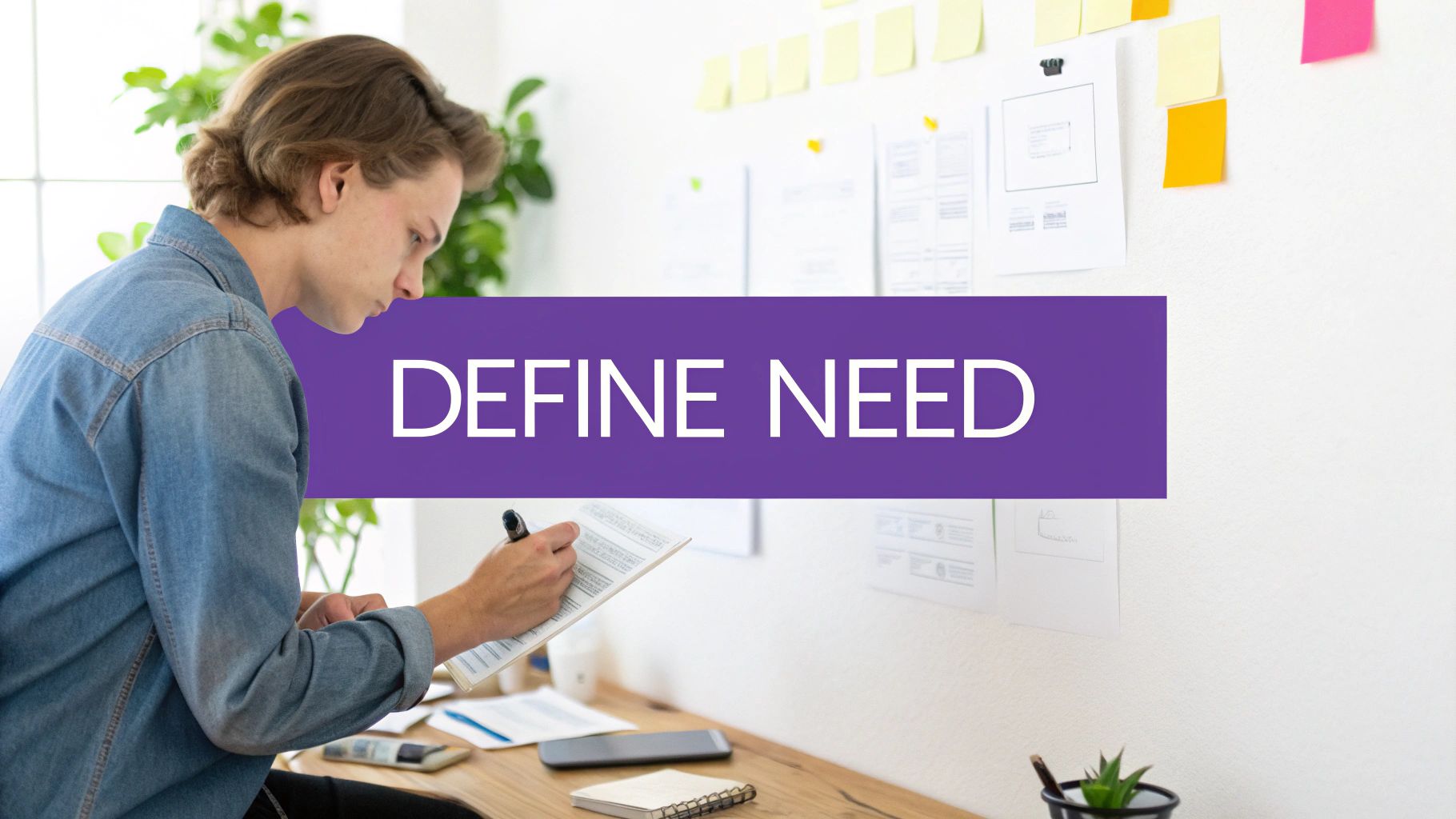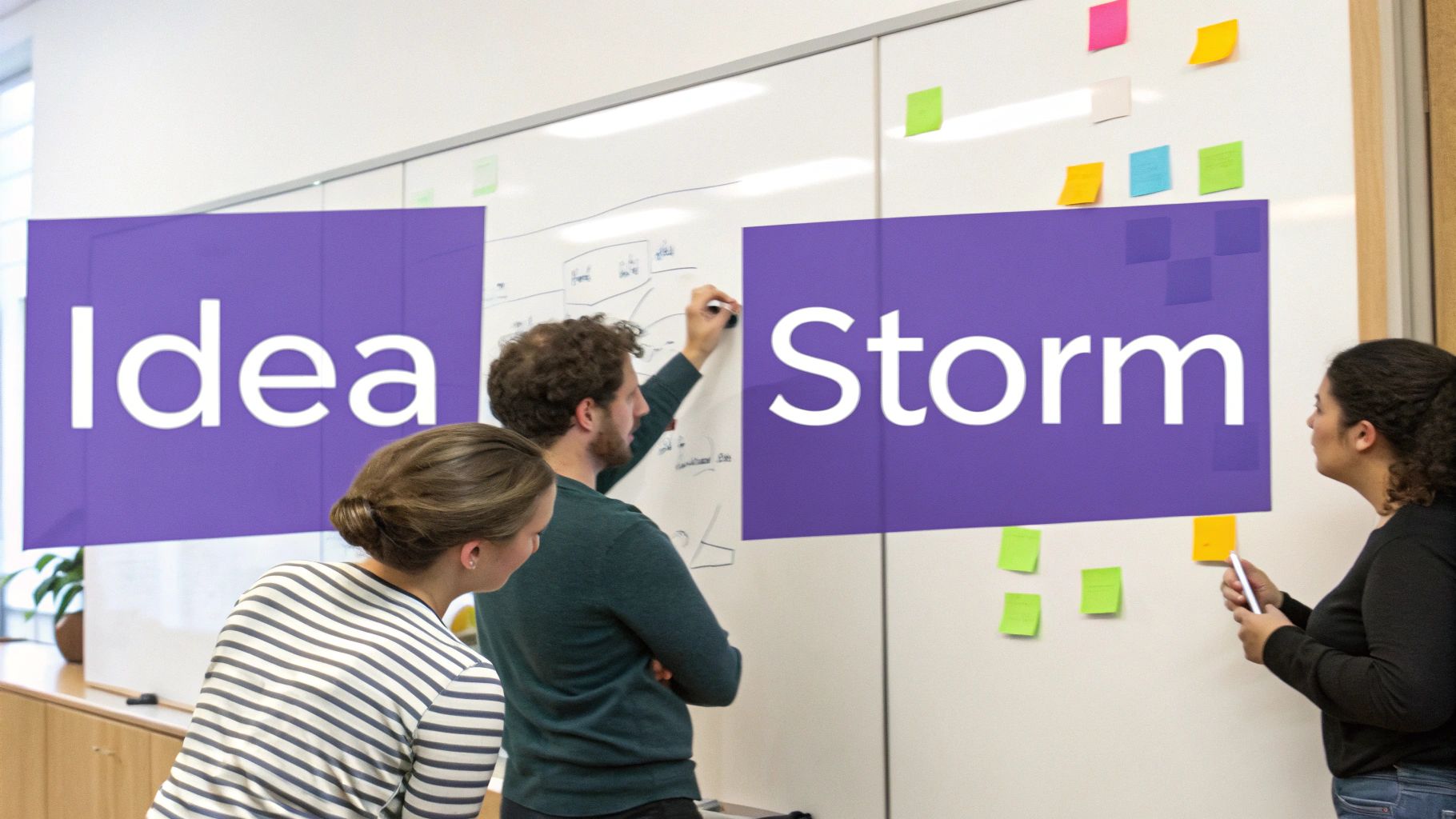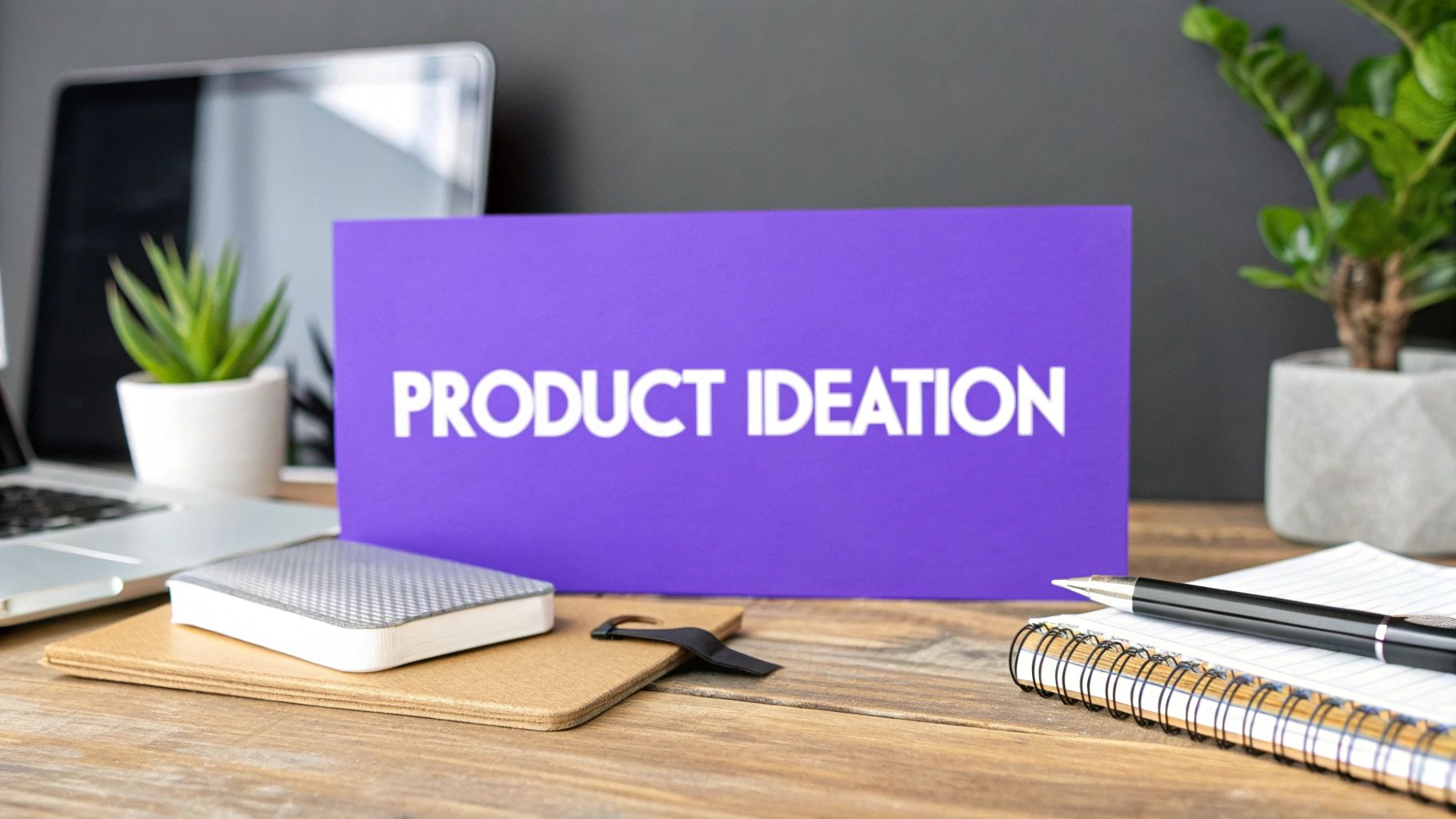The Evolution of Product Ideation: From Brand Men to Innovation Teams

Product ideation is the heart of any successful business. And the way we approach it has changed dramatically. Simply having a "good idea" isn't enough anymore. Today's market is complex. A strategic and structured approach to product ideation is essential for navigating this challenging environment. This evolution shows a fundamental shift in how companies view and pursue innovation.
Historically, product development often relied on the intuition and vision of a few key people. The concept of product management, which includes product ideation, has its roots in the early 20th century. In 1931, Neil H. McElroy at Procter & Gamble introduced the "brand men" concept. These individuals were responsible for overseeing every aspect of a product. They were the forerunners of today's product managers and laid the groundwork for a more structured product development process. Learn more about the history of product management here. This marked a significant move away from relying solely on gut feelings.
The Rise of Customer-Centricity
This early structure paved the way for a critical change: the rise of customer-centricity. Companies started to understand that truly successful products addressed real customer needs. This led to a greater focus on market research, user feedback, and iterative development. Companies began using tools like focus groups and surveys to learn more about their target audience.
Embracing Agile Methodologies
The adoption of agile methodologies further transformed product ideation. Unlike traditional linear approaches, agile focuses on flexibility, collaboration, and rapid iteration. This allows product teams to respond quickly to changing market conditions and customer feedback. Agile fosters a culture of continuous improvement, ensuring products constantly evolve to meet changing market demands. This iterative process allows for adjustments throughout development, rather than sticking to a rigid plan.
The Power of Collaboration
The growing complexity of products and markets has also highlighted the importance of collaboration in product ideation. Cross-functional teams, made up of people with diverse skills and perspectives, are now common. This approach brings different viewpoints together to create more innovative and well-rounded product concepts. These teams use the collective intelligence of the organization to ensure that products are both creative and practical. This collaborative environment encourages a dynamic exchange of ideas, ultimately resulting in more robust, market-ready products. The evolution of product ideation demonstrates a growing recognition of the power of a structured, customer-centric, and collaborative approach to innovation.
Design Thinking: Your Secret Weapon for Product Ideation

Building on the principles of customer-centricity, design thinking provides a robust framework for product ideation. This human-centered approach moves beyond simple feedback collection. It digs deep into the core needs, motivations, and pain points of your target audience.
Instead of simply asking customers what features they want, design thinking encourages exploration of why they desire those features. This deeper level of understanding allows you to create products that truly resonate with users and solve real problems.
Design thinking's emphasis on iterative development and experimentation allows for adjustments throughout the entire product development process. This promotes agility and responsiveness to change.
This means you can quickly adapt to market shifts and integrate user feedback, resulting in products better suited to meet evolving demands.
The Five Stages of Design Thinking
Design thinking generally involves five key stages:
- Empathize: Understand your users' needs and motivations. This can be achieved through observation, user interviews, and immersing yourself in their environment.
- Define: Clearly articulate the specific problem you are aiming to solve for your users.
- Ideate: Generate a wide array of potential solutions, encouraging creativity and diverse perspectives.
- Prototype: Create tangible representations of your ideas, allowing for early testing and valuable feedback.
- Test: Refine your prototypes based on user feedback, iteratively improving your product until it effectively meets user needs.
This structured, five-stage approach enables a more thorough and effective product ideation process. For a more in-depth look at this process, check out this helpful resource: How to Master the Design Thinking Process.
Design thinking has a rich history, influencing product ideation for decades. Its origins trace back to the 1950s and 1960s, gaining mainstream recognition through the work of companies like IDEO in the 1990s. You can delve further into the history of design thinking here.
Design Thinking in Practice
Many successful companies leverage design thinking principles to drive innovation. For example, Airbnb used design thinking to understand the pain points of both travelers and hosts. This led to the creation of a platform that effectively addresses the needs of both groups.
This focus on the user experience has played a vital role in Airbnb's success. Similarly, companies like IBM and Google have integrated design thinking into their product development processes.
By prioritizing the human element, these companies create products that are both user-friendly and commercially successful. This user-centric approach results in greater customer satisfaction and ultimately, drives business success.
Customer-Driven Innovation That Actually Works
Customer-centricity is more than just a popular phrase; it's the foundation of successful product ideation. But how do leading companies truly uncover actionable insights that drive innovation? It's about going deeper than traditional focus groups and discovering the unstated needs customers may not even realize they have. This means understanding not only what customers say, but why they say it, and, even more importantly, what they actually do.
One effective approach is combining qualitative research, such as in-depth interviews, with behavioral data. Analyzing how customers interact with your current products—what features they use, where they struggle, and the workarounds they develop—can reveal hidden opportunities your competitors may overlook. For example, studying user navigation patterns on a website can uncover pain points in the user experience that customers didn't specifically mention in surveys. This combination of qualitative and quantitative data provides a more complete picture of customer needs.
Uncovering Unspoken Needs
Understanding the difference between stated and unstated needs is essential for true innovation. Customers might say they want a particular feature, but their actions might reveal a different underlying need. This is where ethnographic research becomes incredibly valuable. By observing customers in their everyday environment, you can identify the root causes of their problems and uncover opportunities for genuinely innovative solutions. Consider a company designing a new kitchen appliance. Observing how people really cook in their homes reveals far more than simply asking them about their ideal appliance.
Co-creation workshops can also bring customers directly into the product ideation process. These collaborative sessions allow customers to actively participate in creating and refining product concepts, leading to designs that are more relevant and user-friendly. These workshops allow product teams to test their assumptions and gather direct feedback. This direct engagement often sparks unexpected breakthroughs and solutions that would never have come from internal brainstorming alone.
To compare and contrast different research methods, let's look at the following table:
Customer Research Methods Comparison: Comparison of different customer research methodologies for product ideation
| Research Method | Best For | Time Investment | Cost | Insight Depth |
|---|---|---|---|---|
| In-depth Interviews | Understanding individual motivations and experiences | Medium | Medium | High |
| Behavioral Data Analysis | Identifying usage patterns and pain points | Low | Low | Medium |
| Ethnographic Research | Uncovering unstated needs and contextual insights | High | High | High |
| Co-creation Workshops | Generating innovative ideas and refining concepts | Medium | Medium | Medium |
This table highlights the trade-offs between various research methods. While ethnographic research offers deep insights, it requires a significant time and financial investment. Behavioral data analysis is quicker and less expensive, but might not provide the same level of depth.
Balancing Customer Feedback With Visionary Concepts
While customer feedback is invaluable, it's essential to balance addressing current needs with developing visionary concepts. Sometimes, truly groundbreaking products address needs customers haven't yet expressed. This requires strategic foresight and a willingness to take calculated risks. Think of the first iPhone. Customers didn't know they needed a smartphone until Apple showed them what was possible. Finding the right balance between responding to existing needs and anticipating future needs is a core challenge in customer-driven innovation. Further, innovation itself is a critical aspect of product ideation, and it's become more important in our current economy. The "innovation economy" emphasizes the strategic management of innovation as a core business process, with customer knowledge as a vital resource. You can explore this topic in more detail here.
Ultimately, successful product ideation involves deeply understanding your customers, interpreting their needs, and turning those insights into products that solve real problems and offer real value. By using a variety of research methods and embracing a customer-centric approach, companies can create products that not only meet current demands, but also shape the future of their industry.
Validating Product Ideas Before Wasting Resources

After brainstorming and refining product ideas, validation is the next critical step. This involves thoroughly testing your concepts before committing substantial resources. Many successful companies prioritize validation as a cornerstone of their process. They systematically evaluate potential products to ensure they address real market needs. This prevents wasted time and money on products that won't connect with customers. This section explores how companies effectively validate product ideas, transforming concepts into viable products. You might be interested in: How to Master the Essential Innovation Process Steps.
Why Validation Matters
Product development is a challenging journey, often with a high failure rate. Statistics reveal the difficulty of turning ideas into successful products. For every seven ideas, only about four enter development. Of those, roughly one or one and a half launch. And typically, only one of those launched products truly succeeds. Find more detailed statistics here.
Validation improves your chances of success by providing early feedback and identifying potential issues. This allows you to make informed, data-driven decisions about which ideas to pursue and which to abandon. This proactive approach minimizes wasted resources and improves the likelihood of developing a winning product.
Structuring Experiments for Reliable Signals
Effective validation requires well-structured experiments. Product leaders design tests to provide clear signals about market potential. This involves defining clear objectives, identifying the target audience, and choosing appropriate testing methods.
For example, a Minimum Viable Product (MVP) lets you test core features with early adopters. This gathers valuable feedback before building a complete product. A/B testing different versions of a landing page or marketing materials helps determine what resonates best with the target audience. These experiments offer key insights into customer behavior.
Choosing the Right MVP Technique
The best MVP technique depends on factors like your product type, target market, and available resources. A simple landing page might suffice for validating a software idea. A physical prototype might be necessary for a hardware product. Market conditions also play a crucial role in choosing the right validation strategy.
In a fast-changing market, speed is often paramount. A basic MVP can help gather initial feedback and iterate quickly. In a more established market, a more polished MVP might be needed to stand out from competitors.
Interpreting Results and Avoiding Bias
Interpreting validation results objectively is crucial. Confirmation bias, the tendency to favor information confirming pre-existing beliefs, can skew your interpretation. To mitigate this, establish clear success metrics upfront. This creates an objective framework for evaluating results.
This also means seeking diverse perspectives. Actively consider feedback that challenges your assumptions. This data-driven approach ensures decisions are based on evidence, not biases. Remember, validation is iterative. It's about continuously learning and adapting your product based on feedback.
Breakthrough Ideation Techniques Top Teams Actually Use

Top-performing teams go beyond traditional brainstorming to generate innovative product concepts. They use structured product ideation techniques that combine divergent thinking with convergent thinking. Divergent thinking helps generate a wide range of ideas, while convergent thinking narrows them down to the most promising ones. This balanced approach produces ideas that are both new and practical.
Overcoming Groupthink and Fostering Psychological Safety
One common challenge in group ideation is groupthink. This happens when the desire for harmony overrides critical evaluation. Successful teams avoid this by creating psychological safety. This allows team members to voice opinions and challenge assumptions without fear of judgment. It fosters open communication and constructive feedback.
Including diverse perspectives from different departments also helps. Cross-functional collaboration can lead to unexpected insights. For example, having engineers in early ideation sessions helps identify potential technical challenges and opportunities. This proactive approach saves time and resources.
The Power of Constraints
Constraints, often viewed as limitations, can boost creativity. By setting boundaries, teams are forced to think differently and explore unconventional solutions. Limiting the budget for a new product, for instance, can focus teams on essential features and prioritize innovation within those limits. This often leads to more efficient and affordable solutions.
Facilitating Productive Ideation Sessions
Techniques like the SCAMPER method guide teams through a systematic ideation process. SCAMPER stands for Substitute, Combine, Adapt, Modify, Put to other uses, Eliminate, and Reverse. It's a framework for generating diverse ideas based on existing products or concepts. For a deeper dive into problem-solving, check out this resource: How to Master Creative Problem-Solving Techniques.
Asynchronous ideation is another powerful technique. It recognizes that not everyone thrives in traditional brainstorming. Asynchronous ideation lets individuals contribute ideas at their own pace and in their preferred way. This accommodates different thinking styles and often generates a wider range of ideas. This approach is especially popular with remote teams using online collaboration tools.
Combining Asynchronous and Synchronous Methods
The most effective approach often combines asynchronous and synchronous ideation. An initial phase might involve individual brainstorming or online idea sharing. This is followed by a focused synchronous session to discuss, refine, and prioritize the ideas. This blended approach combines individual reflection with collaborative discussion.
The following table summarizes the effectiveness of various ideation techniques:
Product Ideation Techniques Effectiveness
Analysis of different ideation techniques and their effectiveness for various product types
| Technique | Best For | Time Required | Team Size | Success Rate |
|---|---|---|---|---|
| Brainstorming | Generating a large volume of ideas quickly | Short (1-2 hours) | Medium (5-10 people) | Moderate |
| SCAMPER | Improving existing products or finding new uses for them | Medium (2-4 hours) | Small-Medium (3-7 people) | High |
| Asynchronous Ideation | Gathering diverse perspectives from distributed teams | Flexible (days/weeks) | Variable | High |
| Synchronous Ideation | Focused discussion and decision-making | Short-Medium (1-3 hours) | Small-Medium (3-7 people) | High |
| Combined Asynchronous/Synchronous | Balancing individual reflection with collaborative discussion | Medium-Long (2-5 days) | Variable | Very High |
This table illustrates the strengths and weaknesses of each method, highlighting the benefit of a combined approach for maximum effectiveness.
By using these techniques, teams can make product ideation a systematic process that drives continuous innovation. This structured approach ensures that ideas are not only generated but also carefully evaluated and refined, leading to products that truly meet market needs and exceed customer expectations.
Building Your Product Ideation Playbook
A successful product rarely emerges from a single brainstorming session. Instead, it requires a structured approach–a product ideation playbook. This playbook helps transform scattered innovation efforts into a system that consistently delivers winning product concepts. Just like a sports team uses a playbook to coordinate actions and achieve victory, a product ideation playbook guides your team through generating, evaluating, and refining ideas. This structured process ensures a consistent and effective approach to innovation.
Establishing Rhythm and Cadence
Creating a robust playbook begins with establishing a regular rhythm and cadence for your product ideation process. This involves setting aside dedicated time for ideation activities. Consider weekly brainstorming sessions, monthly workshops, or quarterly innovation sprints. Consistency is the key. Much like regular exercise builds physical strength, regular ideation strengthens your team's creative muscles. This predictable schedule creates a culture of ongoing innovation.
Spontaneous ideation can still occur, but a structured process guarantees innovation isn't left to chance. This regular rhythm builds momentum and integrates ideation seamlessly into your team's workflow.
Creating Effective Feedback Loops
Your playbook should incorporate mechanisms for gathering and using feedback. This creates a crucial connection between market signals and creative exploration. Regularly reviewing customer feedback, competitor analyses, and industry trends informs your ideation process. This ensures you focus on ideas that resonate with the market. For example, integrating user feedback from beta testing dramatically improves a product's usability and market fit.
This feedback loop is a two-way street. Sharing early-stage concepts with potential customers offers valuable insights and validation. This iterative process refines your ideas and increases their chances of success.
Developing Evaluation Criteria
Clearly defined evaluation criteria are essential for identifying promising concepts early on. These criteria might include market potential, feasibility, alignment with your business strategy, and potential return on investment (ROI). A shared understanding of these criteria allows your team to make objective decisions. This prioritizes the most promising ideas and avoids emotional attachment to potentially unviable concepts. This objective evaluation focuses resources on ideas with the highest potential for success.
Balancing Short-Term and Long-Term Innovation
A well-rounded playbook balances short-term tactical improvements with long-term, disruptive innovation opportunities. Incremental improvements maintain competitiveness. However, dedicating time to exploring radical ideas can lead to breakthrough products that reshape the market. This balanced approach ensures both continuous improvement and the potential for disruptive innovation.
For instance, a software company might focus on incremental updates to existing products while also exploring innovative new features or entirely new product categories. This two-pronged approach maximizes both short-term and long-term growth.
Measuring and Improving Ideation Effectiveness
Finally, your playbook should include methods for measuring and improving ideation effectiveness. Tracking metrics like the number of ideas generated, the percentage of ideas that enter development, and the overall impact of new products on your business provides valuable data. This data helps identify areas for improvement within your ideation process. For example, if a large number of ideas are abandoned early, it might signal a need to improve initial brainstorming quality or refine your evaluation criteria.
Analyzing these metrics lets you fine-tune your playbook and optimize your entire product ideation process. This data-driven approach ensures your ideation efforts become more effective over time, consistently generating winning product concepts.
Are you ready to transform your remote team’s brainstorming sessions into a powerful engine for innovation? Explore Bulby, the AI-powered brainstorming tool designed specifically for remote teams, and unlock your team's full creative potential.

